Allison Peters Quinn
Spires, arches, and architectural fragments define the language through which interdisciplinary artist Susan Giles communicates our technology-driven worldview. She makes sculptures, installations, and video work to examine our relationship to known architecture and geographic locations: how we identify with the two and how the two tend to define us. Often reducing the scale of monumental or historic buildings to a model, the souvenir-size and generalized features of her sculptures suggest such iconic structures have lost all cultural meaning and context. The disjointed experience of time, place and self that result from our growing reliance on technology is explored through three series of artworks, including the Spliced sculptures, Paper & Concrete sculptures and the Tower sculptures. Simply by changing our perspective of iconic architecture–through a different scale, angle, material, or level of detail–Giles’ artwork evokes multiple associations, critiques, and realizations about our place in the world and communicates a noticeable shift in our perception of the built environment.
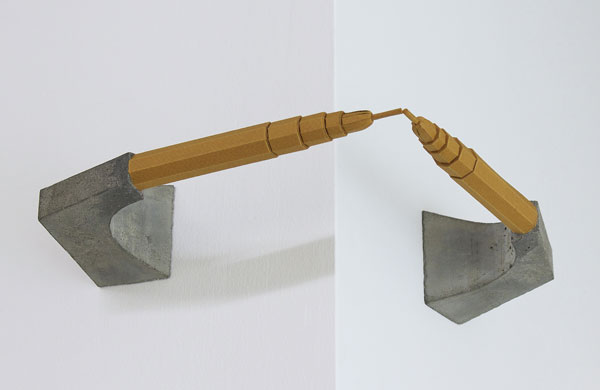
Susan Giles, Petronas Towers/buttress, 2015, Paper and concrete.
Spanning the Industrial Revolution to the Digital Revolution, technology continues to alter the way we understand the world. Screen-based media, in the form of internet, phone, and television provide information about other cultures and geographies through a public archive of images and information. Art historian Claire Bishop has written about the many ways digital technology is shaping the structure of non-digital art practices today, like sculpture, as much as digital art.[1] In response to the internet’s rapid production of material in any subject matter, artists turn toward making sculptures that Bishop called ‘unmonumental’ and ‘precarious’, or well-crafted and delicate, to emphasize tactile and spatial presence that is absent in the digital sphere. Bishop also recognized that with the ease of research, storing content, and obtaining a vast array of information through screen-based media, the artists’ intention of repurposing objects or images from culture is to recontextualize their meaning in society. This repurposing is different from previous generations of appropriation like pop art that addressed consumerism. For Giles, iconic buildings are repurposed into paper sculptures to test their cultural relevance in this era of universal consciousness promoted through tourism. The trajectory of technology is deeply engrained in Giles’ practice and expressed in her sculptures through a complex exploration of perspective.
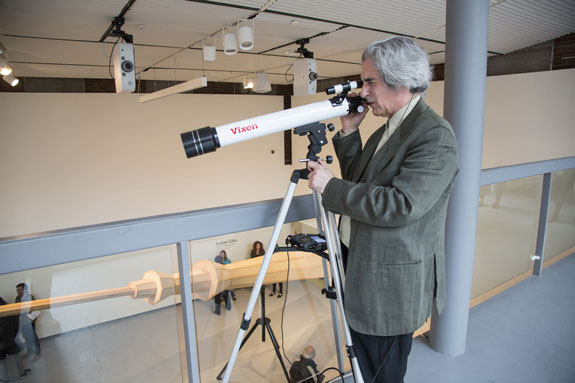
Lou Mallozzi, Outpost, 2011, Performance with telescope, microphone, loudspeakers. Image courtesy Hyde Park Art Center.
The process of making artwork for Susan Giles is dependent upon the internet mediating our worldview. To start, she decides what buildings to recreate by web searching the most photographed buildings (or cliché travel icons) with an interest in representing a variety of global architectural styles. Most of the buildings presented in her work she has never seen in person. She uses the virtual mapping tool Google Earth to generate a 360° view of the structure and produce source images of the building she references. She renders her ideas directly in 3D by building paper models before creating the finished work in a more durable cardstock paper, wood, or cast concrete. Each artwork is meticulously constructed, which reflects an attention to fine detail instilled in her from an early practice in ceramics.
Giles also incorporates personal travel images found online to round out her spatial understanding of the buildings. This treasure trove of digital images presents multiple perspectives from various sources of the same structure, including images taken from above, from street level, at different distances and times of day. In the Paper & Concrete series featuring Arc de Triomphe (2014) and St. Peter’s Basilica/platform (2014), Giles transforms the immaterial shadow into a concrete substructure. A composite form of several daytime views turned into one shadow, the concrete section anchors and tilts the structure with an unsettling effect. Synchronizing many vistas of a destination into one sculpture approaches the same realization of snapshot tourism that artist Zoe Leonard presents through 4,000 postcards of Niagara Falls found online or at flea markets[2]; There is no original visual experience of a popular travel site. For Giles, the steady stream of tourists’ images that pop up in her search results verify this age-old compulsion for people to document architecture, travel, and their self in relation to the two. The photograph and the keepsake statuette contribute to the index of memory and symbolize the desire not to forget an ephemeral experience, like a shadow.
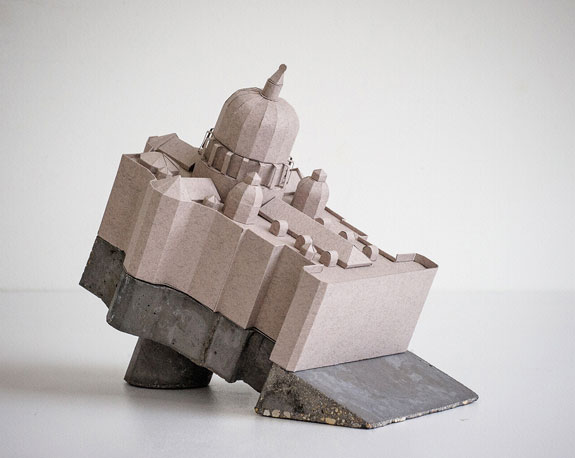
Susan Giles, St. Peter’s Basilica/platform, 2014, Paper and concrete.
Alternating between 2D and 3D information to create the artwork also manifests itself in viewing the sculptures. Giles presents her small sculptures on low pedestals to direct our view from above, referencing the aerial perspective in internet images used to compose the sculptures. The models contain geometric features that flatten from certain vantage points. The Spliced sculptures combine architectural models by inserting one into the body of the other. These hybrid structures showcase an unlikely fusion of institutions, as seen in Taj Mahal and Sydney Opera House(2008), merging seventeenth-century mausoleum with twentieth-century concert hall. The leveling of architectural styles is pushed in a vertical orientation more recently in Zizkov Tower and Steeple/Tower (2015), features two buildings from Prague, the City of Spires. The sculpture orients the spire of the tallest television tower built in the 1980s with the steeple of Church of Saint Prokopios built a century earlier, on the same horizon line. Their proximity raises comparisons with the opposite generational values the buildings represent. Giles skillfully conflates architecture from alternative geographies, histories, and diverse styles into one sculpture that embodies the democratizing ability of the internet.

Susan Giles, Taj/Extrusions, 2016, 3D printed PLA plastic, concrete.
The Tower sculptures follow the same process as described with the smaller sculptures, but go a step further to communicate the influence of technology on a psychological level. Giles increases the size of the model to be many times larger than human scale causing the viewer to adjust to the sculpture’s physicality. Her visual strategy is reminiscent of the work of artist Guillaume Leblon, who exaggerates the scale and reorients the form of signature architectural features to alter our spatial perception of them, often with a ominous tone.[3] The tower/skyscraper is a stereotypical emblem of technological advancement, national power and prosperity. Towers provide tourists an aerial view of the city, yet they disrupt the cityscape. There is a certain violence of these skyscrapers as they loom over everything else in the urban landscape and jut out from the city’s skyline. Through the Tower sculptures, Giles examines the contradictions of these structures and proposes the pursuit for a deeper understanding of these constructed spaces. Architect and activist, Leslie Kanes Weisman writes, ‘Our collective failure to notice and acknowledge how buildings are designed and used to support the social purposes they are meant to serve–including the maintenance of social inequality–guarantees that we will never do anything to change discriminatory design’.[4] Giles follows this feminist critique of urban architecture through the lens of digital images to locate the moment of disjuncture between body and architecture.
A shift occurred in Giles’ work when she presented Crumpled Spire at THE MISSION in 2011. A large skeletal wood sculpture folded into and across the gallery, making it more of an installation than an object. The artwork was based on an unrealized skyscraper by architect Santiago Calatrava intended to be the next tallest tower in Chicago–and the US–before the economic bust in 2008 prohibited its construction. Giles’ abstraction of the building rose to the ceiling and then bends down into the middle of the white cube infusing the core structure of the building with anthropomorphic gesture as it sprawled across the floor, gasping like our bank accounts. There is something satisfying in seeing this symbol of capitalism and machine politics suffer the same losses as the people who would have had to look at it every day. This installation addressed the psychological effects of what Weisman calls ‘anti-human’ architecture that result from a city government’s pursuit for global legitimacy. Similarly, the digital video Pulling Out The Words, made the same year, depicts the loss of language to describe a spatial experience. In response to Giles’ stark edit of the dialogue of individuals describing a landscape, we feel the speakers’ frustration expressed through insufficient hand gestures and awkward vocal sounds. The void in the video parallels the bare quality of the sculpture marking the need for mediation between the body and our designed surroundings. The ideas sketched out in space in Crumpled Spire are made more substantial in the sequential large installation Scenic Overlookat Hyde Park Art Center.

Susan Giles, Scenic Overlook, 2015, Wood and steel.
The four major sculptures presented as an installation in the exhibition Scenic Overlook expand the use of perspective in Giles’ work to address the literal and metaphorical forms of observation. The act of observation requires a subject and an object to reach a better understanding through carefully looking at something over an extended period of time. Giles introduces manufactured tripods into her work, which create the base for the wooden model and emphasize the activity of looking through lens-based technology, like a camera or a telescope. Skyscrapers categorized as observation towers combine the technological hubris associated with building the tallest structure and public access to multiple viewpoints of a city at once, much like an analog version of Google Earth. Observation towers, on the other hand, are zoned non-residential architecture with a primary purpose to provide viewing decks and transmit telecommunications. The view is most likely one way–top down– like the capitalist business model they epitomize. In this series of work, Giles interprets the forms of the tallest observation towers in the world as of 2015, including (in order of tallest): Tokyo Skytree (Japan, architect: Nikken Sekkei), Canton Tower (China, architect: Mark Hemel and Barbara Kuit), CN Tower (Canada, architect: John Andrews), and Ostankino Tower (Russia, architect: Nikolai Nikitin). Exhibited together, the sculptures create a strange conversation by uniting different nations and conflicting politics in the same field, which renders them sterile and indistinct.
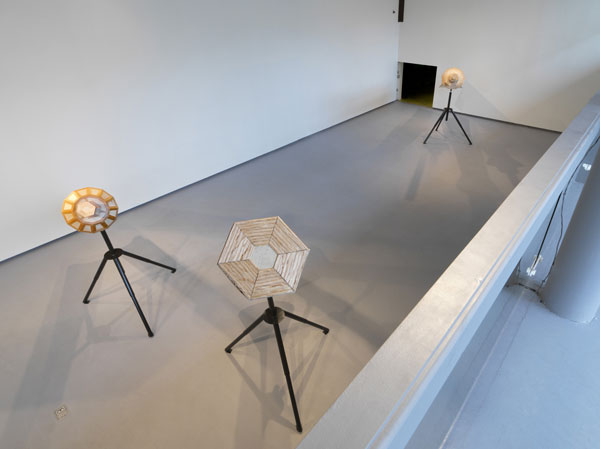
Susan Giles, Scenic Overlook, 2015, Wood and steel.
Dynamically intersecting the space, the Tower sculptures highlight the multiple perspectives in the gallery while replicating the observation function of the original architecture. The sculptures are actually hollow vessels made from varnished modular components seamlessly screwed together, signifying the empty symbols of national identity they have become. Panels of light pine are edge-banded in red birch and maintain a line-drawing quality. Each architect’s signature building morphs to a silhouette as if our memory has already diluted the image of the real building. The warm, natural quality of the wood contradicts the hard steel of a skyscraper that is present in the tripod mount. The material and precision of its construction raises comparisons with an expertly crafted model airplane. In a post-9/11 world, the mention of tower and airplane in the same sentence sends shivers down the spine. The menacing tone is enhanced by the inescapable resemblance between these structures and missiles. Each missile-as-tower is groundless, suspended nearly four feet from the ground and fixed in a diagonal position as if to blast off. An international skyscraper as a weapon causes us to consider the weight of international trade policies on a nation’s economy as a powerful form of warfare.
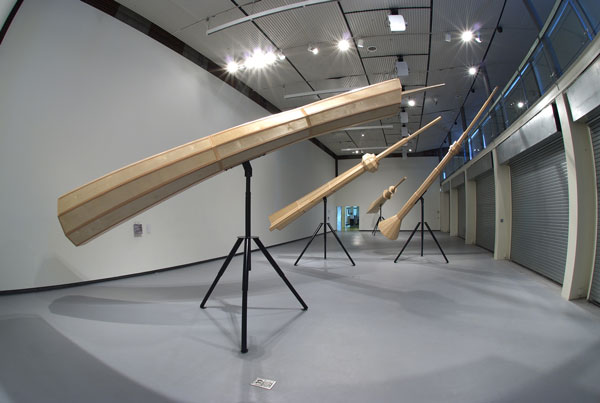
Susan Giles, Scenic Overlook, 2015, Wood and steel.
Surveillance is another form of warfare. All of the sculpture’s spires are fixed on one location like surveillance cameras that point at a space or passageway of concern. The angle of the sculptures encourages the viewer to go up to the viewing balcony or observation deck that overlooks the gallery. There, Giles offers a singular optical experience from this viewing point. The voluminous sculptures collapse in space to two-dimensional floating nonagons and octagons. Close up, the tips of the sculptures appear like floating eyes returning our gaze. The irises and pupils are constructed out of the geometric designs and shades of wood. Who is looking at whom? The aerial view offered from the balcony relates to the circular perspective obtained from an observation tower. Michel Foucault’s analysis of the Panopticon comes to mind as a control mechanism to maintain a gendered, racial imbalance of power through architecture. By empowering the viewer to gaze directly back at the tower, the installation remains hopeful that people have the intelligence and ability to dictate the use of architecture and technology to integrate the world through our experience.
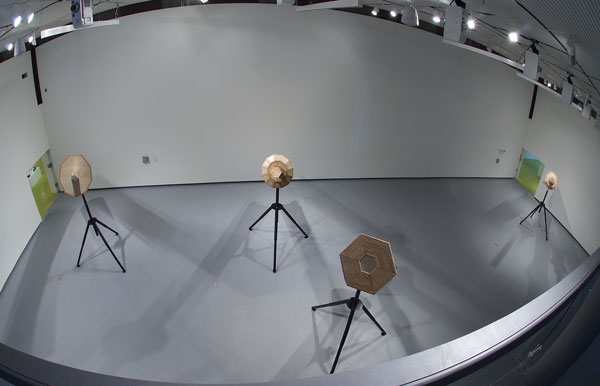
Susan Giles, Scenic Overlook, 2015, Wood and steel.
A close study of artwork produced by Susan Giles over the past decade verifies an ambitious new direction in her practice. Her ongoing assessment of the connection among tourism, architecture, and identity through small sculptures has expanded exponentially with the increased scale and immersive installation of her Tower sculptures. Bringing the role of technology in her practice to the forefront proves the contemporary relevance of her work and compels us to consider the psychological effects of the unavoidable mediated experience of time, place, and culture.
©Hyde Park Art Center, 2015
[1] Bishop, Claire. ‘Digital Divide: Contemporary Art and New Media’, Artforum. 15:1, 2012, 434-441.
[2] Zoe Leonard, You see I am here after all, 2008, 4000 vintage postcards, Installation dimensions vary, exhibited at Dia Beacon (NY), September 21, 2008 – January 9, 2011. The exhibition press release describes the installation: ‘Leonard presents several thousand vintage postcards of Niagara Falls, dating from the early 1900s to the 1950s … En masse, they reflect decades of changing technologies during which the motif of the Falls, shot from a few standard vantage points, was revisioned: hand-colored, over-painted, cropped, or otherwise manipulated in accordance with changing notions of truth and taste. Organized by viewpoint and installed in grids, the ensemble unfolds along the wall like a Chinese scroll with one renowned vista succeeded by another.’
[3] Guillaume Leblon, Mur Barasti (2004), installation exhibited at Frac Bourgogne (France), January 24 – March 27, 2004. According to the exhibition press release, Mur Barasti ‘extended between two walls and is based on a roof conceived by Egyptian architect, Hassan Fathy. The viewer, hesitating between an apparently familiar world and one which escapes any immediate perception of it, acquires a feeling that Freud calls ‘strange anxiety.’’
[4] Weisman, Leslie Krane. Discrimination by Design: A Feminist Critique of the Man-Made Environment (Urbana: Illini Books,1994), 35.
Susan Giles’ sculpture and video reflects our longing for the ideal, and the construction of identity in relation to physical place. She explores these ideas through the big picture – in monuments, language, and architecture – or through the everyday life of the individual – in anecdotes, souvenirs and blogs. Giles’ work has shown in Chicago at THE MISSION Gallery, the Museum of Contemporary Art, and The Renaissance Society, as well as Mixed Greens in New York and Galeria Valle Orti in Valencia, Spain, among others. She has received several grants, including an Individual Artist Project Grant from DCASE in 2015, awards from the Illinois Arts Council in 2014 and 2009, a 2005 Louis Comfort Tiffany Award and a 1998 Fulbright Grant to Indonesia to conduct research on the intersection of tourism and culture in Bali. Giles is an Assistant Professor in the Department of Contemporary Practices at The School of the Art Institute of Chicago.
Allison Peters Quinn is a curator and writer based in Chicago. Her work over the past 10 years has been focused on projects that address intersections between art, architecture, and socially-engaged practices. Her essays have appeared in art anthologies including Service Media: Is it Public Art or Art in Public Space (2013), and The Artists Run Chicago Digest (2009) in addition to Proximity Magazine and artists’ monographic publications on Cándida Alvarez, Susan Giles, Jefferson Pinder and William Steiger to name a few. She has organized significant exhibitions for emerging and established artists such as Bibiana Suarez, Juan Angel Chavez, and Theaster Gates. Quinn is currently the Director of Exhibition & Residency Programs at Hyde Park Art Center and teaches at the University of Chicago Graham School.